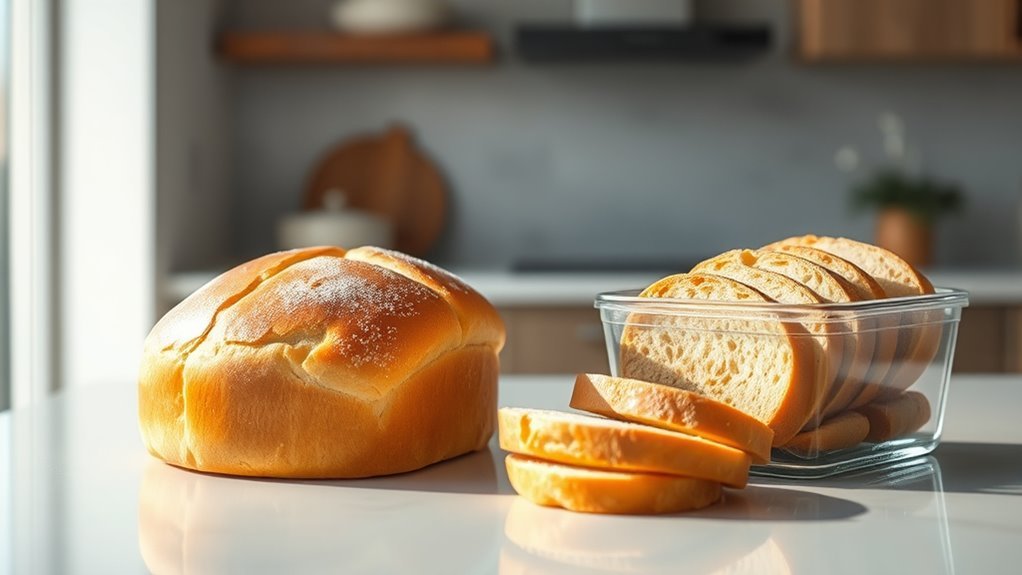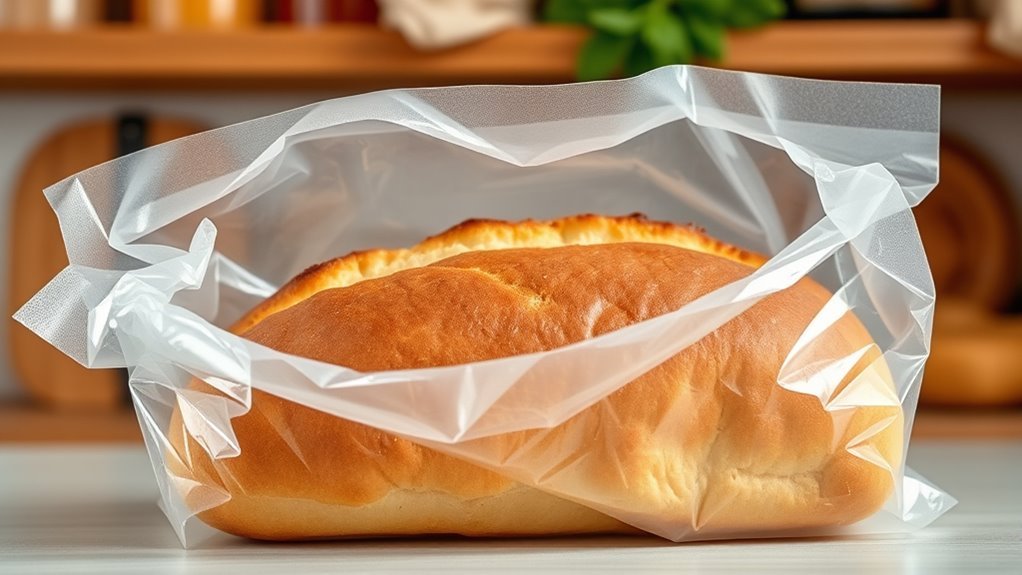Yes, you can freeze keto bread to extend its shelf life without sacrificing flavor or texture. Make sure the bread is completely cooled before wrapping it tightly in airtight packaging, like plastic wrap or freezer bags, to prevent moisture loss. Store it at a temperature of 0°F (-18°C) or lower. When you’re ready to enjoy it, just thaw it at room temperature or warm it in the oven. You’ll find plenty of tips and creative uses for your leftover keto bread!
Understanding Keto Bread and Its Ingredients

When you’re diving into the world of keto bread, it’s essential to understand its unique ingredients and how they differ from traditional bread. Unlike conventional bread types that rely on wheat flour, keto bread often uses keto ingredients like almond flour, coconut flour, or flaxseed meal. These alternatives greatly reduce carbohydrate content, making them perfect for a low-carb lifestyle. Additionally, many recipes incorporate eggs, cheese, or psyllium husk to enhance texture and moisture. It’s all about embracing healthier options while still enjoying the satisfaction of bread in your diet. Understanding these ingredients helps you make informed choices, allowing you to savor each bite without the guilt. So, explore these alternatives and feel empowered in your keto journey! Moreover, using low-carb sweeteners can enhance flavor without impacting your dietary goals.
Best Practices for Freezing Keto Bread

To keep your keto bread fresh when freezing, start by ensuring it’s completely cooled. This prevents moisture buildup, which can lead to freezer burn. Once cooled, store it in airtight packaging to maintain its texture and flavor.
Proper Cooling Techniques
Cooling keto bread properly before freezing is vital for maintaining its texture and flavor. To achieve the best results, use effective cooling methods like placing the bread on a wire rack. This allows air to circulate around it, preventing moisture buildup. Let it cool for at least 30 minutes; this cooling time is important for avoiding sogginess when you freeze it. If you’re in a hurry, you can slice the bread before cooling, which speeds up the process. Just remember, the goal is to guarantee all parts are completely cool to maintain that delightful keto goodness. Once cooled, you can wrap and freeze it, keeping your bread fresh for future enjoyment without sacrificing quality.
Ideal Storage Conditions
Although freezing keto bread can extend its shelf life, it’s essential to store it under the right conditions to preserve its taste and texture. First, make sure the bread is fully cooled before freezing to avoid excess moisture. Wrap it tightly in plastic wrap or aluminum foil to protect against freezer burn. The ideal temperature for freezing is 0°F (-18°C) or lower. This prevents the bread from spoiling and maintains its quality. Additionally, keep humidity levels low in your freezer. Excess moisture can lead to ice crystals, affecting the bread’s texture upon thawing. By following these best practices, you can enjoy delicious, fresh-tasting keto bread anytime, giving you the freedom to indulge without worry! Using gluten-free flours such as almond flour can further enhance the quality of your keto bread after thawing.
How to Properly Wrap and Store Keto Bread

To keep your keto bread fresh and tasty, it’s crucial to wrap and store it properly. Start by choosing the right wrap to protect against freezer burn, then use effective storage techniques to maximize its shelf life. Finally, knowing how to thaw and reheat your bread will guarantee you enjoy it just as much as when it was fresh.
Choosing the Right Wrap
When it comes to preserving the freshness of your keto bread, choosing the right wrap can make all the difference. You’ll want to take into account various wrap types and material choices to keep your bread tasting great. Plastic wrap is a popular option because it creates a tight seal, preventing air exposure. However, if you prefer a more eco-friendly choice, beeswax wraps are reusable and effective. Aluminum foil also works well, providing a sturdy barrier against freezer burn. Just remember to wrap your bread tightly, regardless of the material you choose, to maintain its texture and flavor. By selecting the right wrap, you can enjoy your keto creations without compromising on quality or taste!
Freezer Storage Techniques
Properly wrapping and storing your keto bread is essential if you want to maintain its freshness and flavor while it’s frozen. Start by using airtight storage containers or freezer bags to guarantee no air gets in. Label each container with the date to keep your freezer organized. Additionally, ensure that your keto bread is made from low-carb vegetables to maximize its suitability for the ketogenic diet.
Here’s a simple table to help you visualize your storage options:
| Storage Method | Pros | Cons |
|---|---|---|
| Freezer Bags | Space-efficient | Can tear easily |
| Airtight Containers | Reusable and durable | May take more space |
| Aluminum Foil | Excellent insulation | Not reusable |
| Plastic Wrap + Bag | Cost-effective | Less durable |
| Vacuum-Sealed Bags | Long-lasting freshness | Requires special equipment |
With these techniques, you’ll enjoy your keto bread at its best!
Thawing and Reheating Tips
After storing your keto bread correctly, the next step is knowing how to thaw and reheat it effectively to enjoy the best taste and texture. For thawing methods, you can simply leave the bread at room temperature for a couple of hours or use the microwave for a quicker option—just be careful not to overdo it. If you prefer a softer crust, wrap it in a damp paper towel while microwaving.
When it comes to reheating techniques, the oven is a great choice to revive that fresh-baked flavor. Preheat it to 350°F, then warm the bread for about 10 minutes. Alternatively, a toaster can give you a delightful crunch. Enjoy your keto bread as if it was just baked!
Thawing and Reheating Keto Bread
Thawing and reheating keto bread can be a breeze if you know the right techniques. For effective thawing methods, you can leave the bread at room temperature for about 30 minutes, or pop it in the microwave for a quick defrost. If you prefer a fresher taste, consider using the oven at a low temperature to slowly bring it back to life.
When it comes to reheating techniques, the oven is your best friend for achieving a crispy crust. Just wrap the bread in foil and heat it at 350°F for about 10-15 minutes. Alternatively, you can use a toaster for individual slices. With these simple steps, you’ll enjoy your keto bread just as fresh as the day you made it!
Signs of Freezer Burn and How to Avoid It
While freezing keto bread can be a great way to extend its shelf life, it’s essential to recognize the signs of freezer burn to guarantee you’re enjoying the best quality. Freezer burn occurs when moisture loss leads to dry, discolored patches on your bread. Here are some signs to look for:
| Signs of Freezer Burn | Description | Action Needed |
|---|---|---|
| Dry Spots | Patches of dryness | Use immediately or discard |
| Discoloration | Grayish or whitish areas | Discard if severe |
| Ice Crystals | Visible ice on bread | Remove and consume soon |
| Off Odor | Unpleasant smell | Discard |
| Texture Change | Gummy or crumbly feel | Use in recipes |
Tips for Keeping Keto Bread Fresh After Freezing
To keep your keto bread fresh after freezing, it’s essential to follow a few simple tips that can make a big difference in quality. First, always wrap your bread tightly in plastic wrap or aluminum foil before placing it in an airtight container or freezer bag. This helps prevent freezer burn and maintains freshness. Pay attention to the storage duration; ideally, consume your frozen keto bread within 3 months for the best taste and texture. When you’re ready to eat, look for freshness indicators like texture and aroma. If it feels dry or smells off, it might be time to toss it. By following these tips, you can enjoy delicious, fresh keto bread anytime you want! Additionally, ensure that the bread is made from high-quality low-carbohydrate ingredients, as this can significantly affect its flavor and texture after freezing.
Creative Ways to Use Leftover Frozen Keto Bread
If you’ve got leftover frozen keto bread, there are plenty of creative ways to put it to good use. Don’t let it go to waste! Here are some fun ideas to inspire you:
- Top it with creative toppings for a delicious snack.
- Make keto sandwiches by layering your favorite fillings.
- Blend it into bread crumbs for casseroles or coatings.
- Whip up breakfast toast with eggs and avocado.
- Transform it into keto croutons for salads or soups.
You can even indulge your sweet side with French toast or bread pudding. And if you’re feeling savory, garlic bread is always a hit. With these options, your leftover keto bread can be a delightful addition to any meal! Additionally, proper tools like a high-quality non-stick loaf pan can help ensure your next batch of keto bread turns out perfectly.
Frequently Asked Questions
Can I Freeze Store-Bought Keto Bread?
Yes, you can freeze store-bought keto bread! Most keto bread brands are designed to maintain their quality even after freezing. Just make sure to wrap it tightly in plastic wrap or foil to prevent freezer burn. When you’re ready to enjoy it, simply thaw it in the fridge or toast it straight from the freezer. This way, you’ll always have delicious keto bread on hand, giving you the freedom to stick to your diet!
How Long Can Frozen Keto Bread Last?
Frozen keto bread can last up to three months without losing its quality. Did you know that proper freezing methods can maintain flavor and texture? To maximize freshness, wrap your bread tightly in plastic wrap or aluminum foil, then place it in an airtight container. For best results, avoid thawing and refreezing. When you’re ready to enjoy it, simply toast or warm it up. These storage tips guarantee you always have delicious keto bread on hand!
Does Freezing Affect the Taste of Keto Bread?
Freezing keto bread can affect its taste and texture. While it generally preserves flavor, some people notice slight changes after thawing. You might experience minor texture changes, making it less fluffy than fresh bread. To maintain ideal taste preservation, wrap the bread tightly before freezing. When you’re ready to enjoy it, thaw it in the fridge or at room temperature for the best experience. Embrace the freedom of having keto bread on hand anytime!
Can I Freeze Keto Bread With Toppings?
Yes, you can freeze keto bread with toppings, but it’s best to choose simple topping combinations. For instance, avoid freezing bread with fresh veggies or sauces that might become soggy. Instead, consider using cheese or deli meats, which freeze well. When you’re ready to freeze, wrap the bread tightly in plastic wrap, then place it in a freezer bag to preserve freshness. Just remember to reheat it properly for the best taste!
Is It Safe to Refreeze Thawed Keto Bread?
Yes, it’s generally safe to refreeze thawed keto bread, but you should be cautious about the thawing methods you use. If you’ve thawed it in the fridge, you’re good to go. However, if you’ve used a quick method like microwaving, it’s better to eat it right away instead of refreezing. Refreezing can impact texture, so make sure to store it properly to maintain that delicious keto taste you love!


